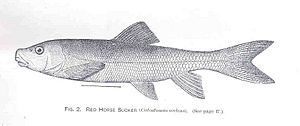Utah sucker facts for kids
Quick facts for kids Utah sucker |
|
|---|---|
 |
|
| Conservation status | |
| Scientific classification |
The Utah sucker (Catostomus ardens) is a type of freshwater fish. It belongs to the Catostomidae family, which are often called "suckers" because of their mouth shape. This fish lives in the western parts of North America. You can find it in the upper Snake River and around the old Lake Bonneville areas.
Utah suckers can live in many different places, like lakes and rivers. They are quite large, growing up to about 65 centimeters (25 inches) long. Their bodies are usually dark on top and white underneath. They often have a faint pink stripe along their sides. This fish has thick lips and its mouth is located on the underside of its head. Even though some groups of Utah suckers are facing problems, the species as a whole is not currently in danger.
Contents
What the Utah Sucker Looks Like
The Utah sucker is a big fish. It can grow to be about 65 centimeters (25.5 inches) long. Its body is long and slender. The area on its back, between its head and its top fin (called the dorsal fin), is a bit raised.
Its mouth is completely under its snout. It has thick lips. The upper lip has eight rows of small bumps called papillae. The bumps in the second and third rows are bigger than the others.
The fish is usually dark, almost black, on its upper side. It might have faint spots or blotches. There is a narrow, rosy (pinkish) band along the front part of each side of its body. Its underside is white.
The long fin on its belly (called the anal fin) is placed far back on its body. The tip of this fin reaches almost to the base of its tail fin (called the caudal fin). The anal fin has seven rays, which are like bony supports. The dorsal fin, on its back, has 13 rays.
Scientists have studied the genes of Utah suckers. They found that fish from the ancient Snake River and the Bonneville Basin are quite different from each other, even if they look similar.
Where the Utah Sucker Lives
The Utah sucker is originally from the upper Snake River and the Lake Bonneville areas in western North America. It can live in many different types of watery places. You can find them in lakes, rivers, and streams. They can live in both warm and cold water. They also don't mind if the bottom of the water is made of mud, sand, gravel, or rocks. They especially like areas where there are plants growing in the water.
How the Utah Sucker is Doing
Some groups of Utah suckers are facing challenges. These problems are often caused by human activities. For example, their homes (habitats) can be destroyed. Water can be taken away from their rivers, or barriers can stop them from moving to different areas. Pollution from chemicals can also hurt them. Sometimes, new types of fish that are not native to the area compete with the Utah suckers for food and space.
Back in 1881, two scientists named David Starr Jordan and Charles Henry Gilbert saw huge numbers of Utah suckers in Utah Lake. They said there were "simply enormous" amounts of them. Since then, the number of fish in Utah Lake has gone up and down many times.
Sometimes, people have been confused about the names of these fish. The Utah sucker in Utah Lake was once mixed up with another fish called the June sucker. For a while, the name Catostomus fecundus was also used for this fish.
See also
 In Spanish: Catostomus ardens para niños
In Spanish: Catostomus ardens para niños


